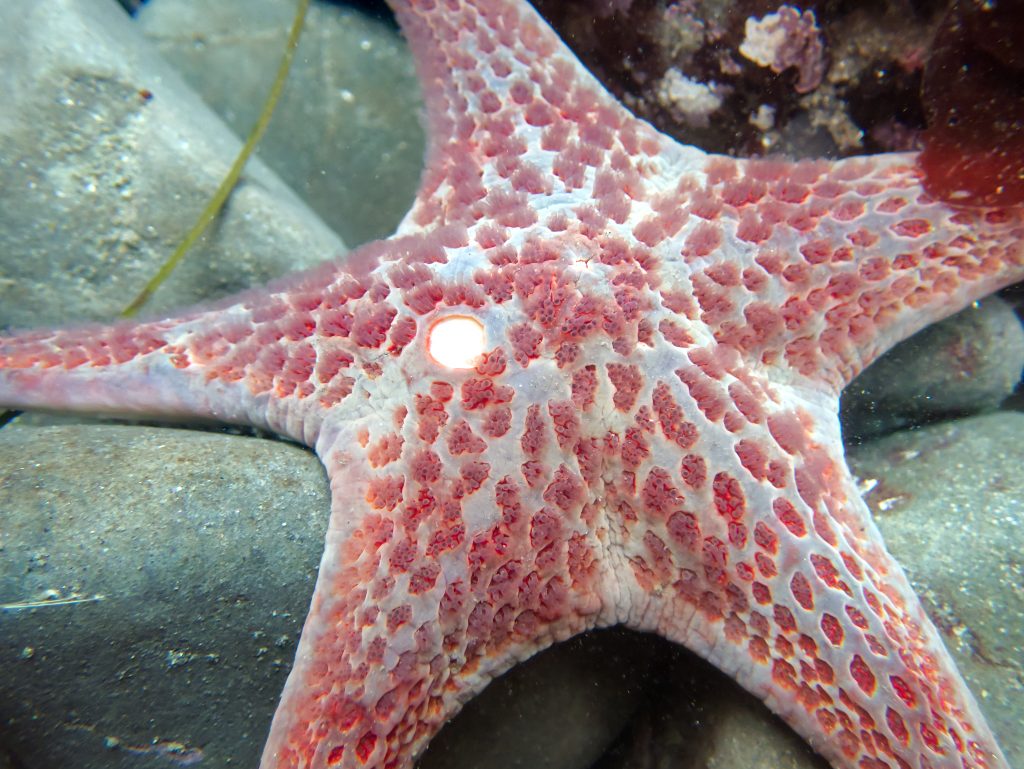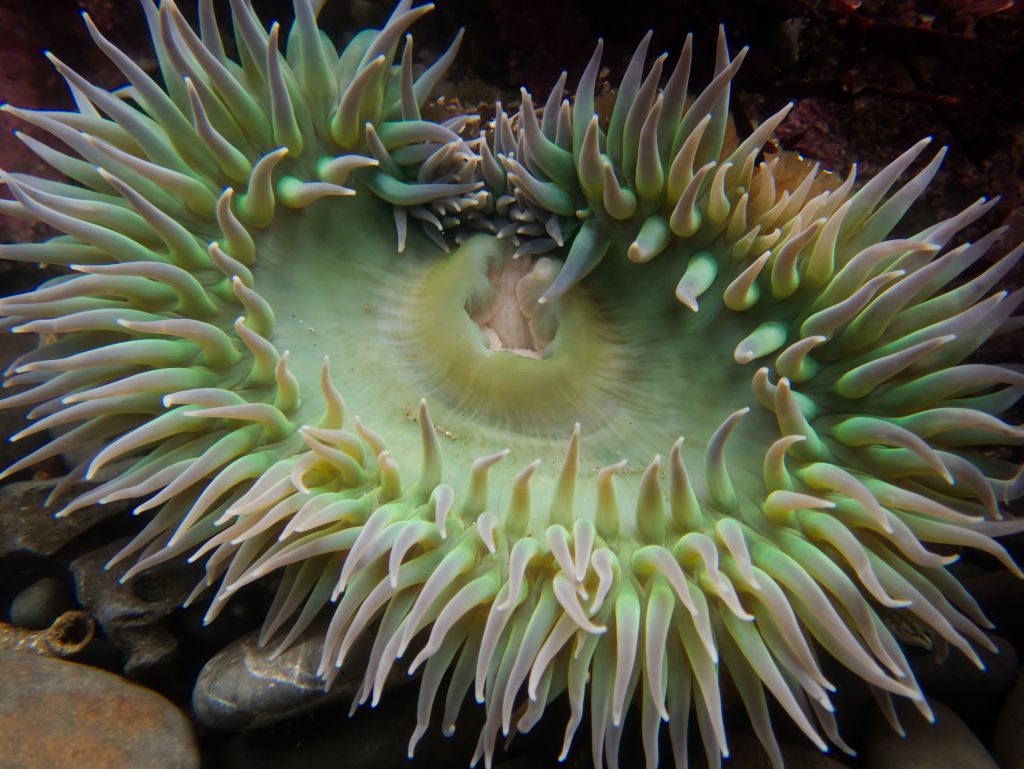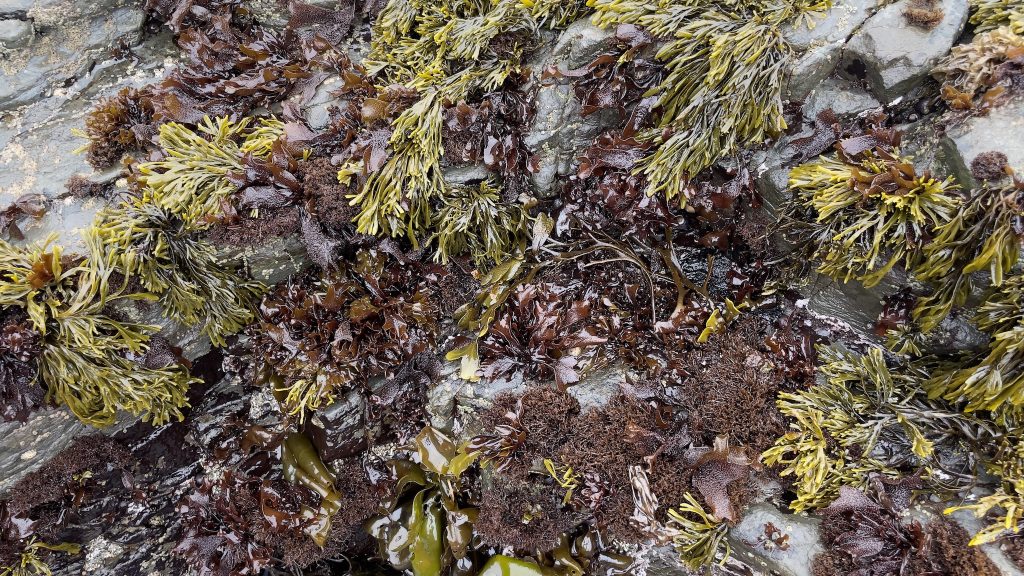Sometimes things just work out, through no fault of my own. In terms of good minus tides occurring in daylight hours, this weekend’s tides are the best we will have all season. Today (Saturday 29 May) is the third of five intertidal excursions I have planned. This morning I went up to Pistachio Beach to collect some things for the Seymour Center. I always feel a teensy bit apprehensive agreeing to collect for anybody but myself, because it is quite likely that I will get skunked and not be able to bring back what is needed. So usually I just agree to keep my eyes open for things that are on the wish list and make no promises.
The current wish list for the Seymour Center includes fishes. I’ve already brought them some sculpins and a clingfish, but small pricklebacks are also welcome. Pistachio is a popular place for people who fish for large pricklebacks. Apparently they (the pricklebacks) put up a good fight and make tasty eating. The usual way of fishing for them is poke-poling. I am not entirely sure how that works, but it involves a long pole and baited hooks. I think the idea is to lure a prickleback out from its hiding place at low tide, when it is sort of stranded away from open water. Adults get up to 70-80 cm long, and are as big around as my forearm.
Unlike the fishermen, I was fishing for young pricklebacks, hoping to find some that were about the length of my hand. Possessing the ideal set of characteristics for avoiding capture—a long eel-like body, small head, slimy coating, and the ability to augur really quickly into even the tiniest crack amongst the cobbles—these small fish led me on a merry chase for quite a while. However, the advantages that I have over even a wily prickleback are an enlarged cerebral cortex, opposable thumbs, and the dexterity to use both a dip net and a zip-loc baggie. When all was said and done I had two appropriately sized pricklebacks in my baggie, and two others had gotten away from me. Oh, and I did also bag another clingfish!
Having had that bit of success and not wanting to press my luck, I started poking around just for the hell of it, without any clear objective in mind. As I’ve said before, what we gain from a super low tide like this (-1.6 ft) is not only access to more real estate in the low intertidal, but more time to spend there before the tide returns. I took lots of photos, which I will present in chronological order. These will give you an idea of what it was like out there this morning.
Even the hike across the beach yielded something nice—this small stand of Postelsia palmaeformis, the sea palm. These poor junior kelps will be taking a beating with these spring tides rushing up and down. That’s the price they pay for living out there on those exposed rocky points.
The leather star Dermasterias imbricata isn’t one of the most common stars in the intertidal around here. It was one of the species that was hit pretty hard by the most recent outbreak of Sea Star Wasting Syndrome. We see one every so often, but they are nowhere as abundant as the ochre stars or bat stars.
Pistachio Beach isn’t the best place for large anemones, but of course there are some. This is one of the few big Anthopleura anemones that I saw today. There are many of the small cloning anemones, A. elegantissima, in the high intertidal, as well as the moonglow anemones, A. artemisia, in the mid and low sandy areas.
I was so pleased to see my favorite red alga doing really well in the low zone! It is so pretty.
And at the same time I accidentally discovered a pretty big rock crab, which was tucked under a rock. For its species, this one was pretty calm and didn’t come at me with big claws up. It could be that this crab is a male, and is clasping a female beneath him. I didn’t check.
One of the things I found while turning over rocks to look for fish is this purple urchin:
And a bit later, a nice healthy group of Dictyoneurum californicum. As these thalli age, they will develop longitudinal splits at the base of the blades. Right now they are young and crispy.
And who can resist such an exuberantly decorated limpet? Certainly not I! Reminds me of the fancy hats that ladies used to wear for Easter. Or Beach Blanket Babylon.
Chitons, the overlooked molluscs that reach peak abundance and diversity in the intertidal, can be very common along the coast. Species composition varies from site to site, though. Here at Pistachio Beach, the two species of Tonicella are very common. I found several of them on the undersides of rocks. This one is T. lokii.
After two hours of catching fish and looking around, I was getting cold. Time to head back up and out. That took an additional half-hour or so, because I kept getting distracted by the algae. For example, look at how beautiful this Fucus is. And note the swollen tips, which mean this thallus is getting sexy. ‘Tis the season, after all.
One of the other rockweeds, Pelvetiopsis limitata, was also very thick and abundant.
The rockweeds share the high intertidal with a few species of red algae. The most common reds in this zone are the two (or however many there are) species of Mastocarpus, and Endocladia muricata.
I always want to stop and look around in the high zone on my way down. Because when I walk past sights like this, it’s hard not to stay and study more closely. Then I remember that I can take as much time as I want in the high zone on the way out. This morning I took lots of photos of these reds and rockweeds.
How many different types of seaweed can you see?
So there you have it, my morning summarized in about a dozen photos. I hope your Saturday was as enjoyable as mine was!














The Tonicella lokii is beautiful! Thanks for sharing your discoveries with us.
You’re most welcome! The Tonicella limpets are indeed very beautiful, sometimes almost too brilliantly colored to be real.